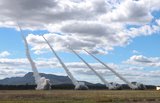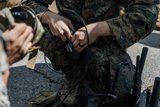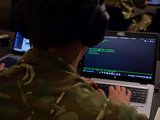Forecast International projects $28.4 billion market for leading Electronic Warfare programmes
Forecast International's "The Market for Electronic Warfare Systems" projects an estimated $28.4 billion will be spent over the next 10 years on the development and production of the major EW systems. Some 44,807 units of leading electronic countermeasures (ECM), radar warning receivers (RWRs), electronic support measures (ESM), and other EW systems that make up this analysis will be produced.
The top-ranked EW producers cited in the analysis (out of a total of 22 companies considered) are Northrop Grumman, BAE Systems, Raytheon, ITT, and Lockheed Martin. While production of leading missile countermeasures systems has helped position some of these companies at the top of the ranking, others are leading the development of all-important, next-generation technology.
It is important to add here that today's EW market leaders are firmly established because of their ability to provide much-needed EW systems for immediate deployment to the battlefield. To cite just one example, despite some defense budget tightening, the Pentagon is expected to spend over $560 million through FY13 on procurement of Northrop Grumman's Large Aircraft Infrared Countermeasures (LAIRCM) system for various Air Force aircraft. The service has declared that its long-range desire is to equip a total of 444 aircraft with the system.
According to Forecast International senior analyst Andrew Dardine, "While production of critical EW systems like counter-IED and IR-guided missile jammers will be high over the next few years, several R&D programmes are in a competition phase that will eventually result in billions of dollars in revenue for the companies chosen to supply technologies for them."
Within the next two years, winners are expected to be selected for the coveted Next-Generation Jammer (NGJ) programme. The US Navy, in early 2009, awarded NGJ research contracts to teams led by BAE Systems, ITT, Northrop Grumman, and Raytheon. By late 2012, the Navy plans to award an engineering and manufacturing development (EMD) contract to a single supplier. The total value of the NGJ programme once it gets up and running will be nearly $1 billion.
The market for systems to defeat improvised explosive devices (IEDs) will also warrant close monitoring in the years ahead. With the recent surge of US troops into Afghanistan, there has also been an increase in the occurrence of IED attacks. To counter these attacks, a competition is currently under way for development of a Counter Radio-Controlled Improvised Explosive Device (RCIED) Electronic Warfare (CREW) 3.3 system of systems. The US Naval Sea Systems Command in October 2009 awarded firm-fixed-price contracts to two companies for CREW 3.3 System of Systems development. ITT Force Protection Systems was awarded $16 million, while Northrop Grumman Space and Mission Systems, Network Communication Systems was awarded $24.3 million.
International ventures will also have a significant impact on the EW market through the new decade. The primary platform for ITT's ALQ-214 Radio Frequency Countermeasures (RFCM) system is the US Navy's F/A-18E/F Super Hornet. Through its association with the jet fighter, a potentially growing export market for the ALQ-214 has begun to emerge. For example, the system will equip the F/A-18Fs purchased by Australia a stopgap measure until its F-35 fleet is ready for service. Deliveries of the F/A-18F to Australia are currently under way.
Source: Forecast International
More from Digital Battlespace
-
![Australia looks towards space with force restructure, investment and training]()
Australia looks towards space with force restructure, investment and training
Australia is looking to improve its presence in space with a focus on communications and creating a dedicated segment of its defence forces committed to the domain.
-
![EID to unveil new vehicle communication system at DSEI]()
EID to unveil new vehicle communication system at DSEI
The Portuguese company’s naval communications system is in service across more than a dozen countries. It has turned to its home nation for support in developing a new vehicle based C2 system.
-
![Chess Dynamics successfully demonstrates Vision4ce AI-driven tracker]()
Chess Dynamics successfully demonstrates Vision4ce AI-driven tracker
The Vision4ce Deep Embedded Feature Tracking (DEFT) technology software is designed to process video and images by blending traditional computer vision with artificial intelligence (AI) algorithms to present actionable information from complex environments.
-
![Wave Relay devices cleared for security use on commercial systems in industry trend]()
Wave Relay devices cleared for security use on commercial systems in industry trend
Persistent Systems has been cleared by National Security Agency (NSA) to transmit sensitive data on commercial networks. The devices are added to the NSA’s Commercial Solutions for Classified (CSfC) component list which also includes other companies’ products providing the same security.
-
![UK teases cyber spending boost in Strategic Defence Review ahead of “imminent” release]()
UK teases cyber spending boost in Strategic Defence Review ahead of “imminent” release
The release of the UK’s Strategic Defence Review (SDR) has been long promised as mid-year. It is possible it could be as early as 2 June although the UK Ministry of Defence (MoD) continues to play its cards close to its chest.
-
![Intelsat emphasises SATCOM resilience for SOF in contested domains (video)]()
Intelsat emphasises SATCOM resilience for SOF in contested domains (video)
Intelsat outlines how its multi-orbit SATCOM architecture is enhancing connectivity and resilience for special operations forces operating in degraded and contested environments.























